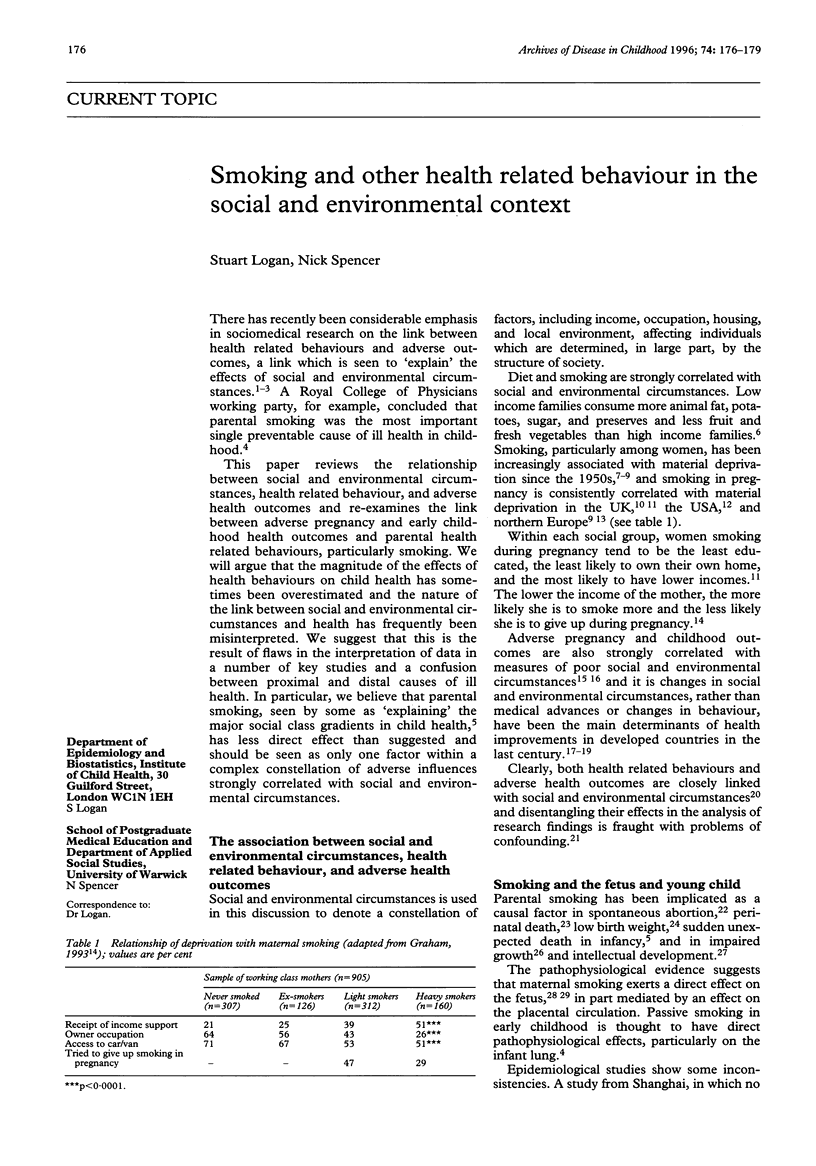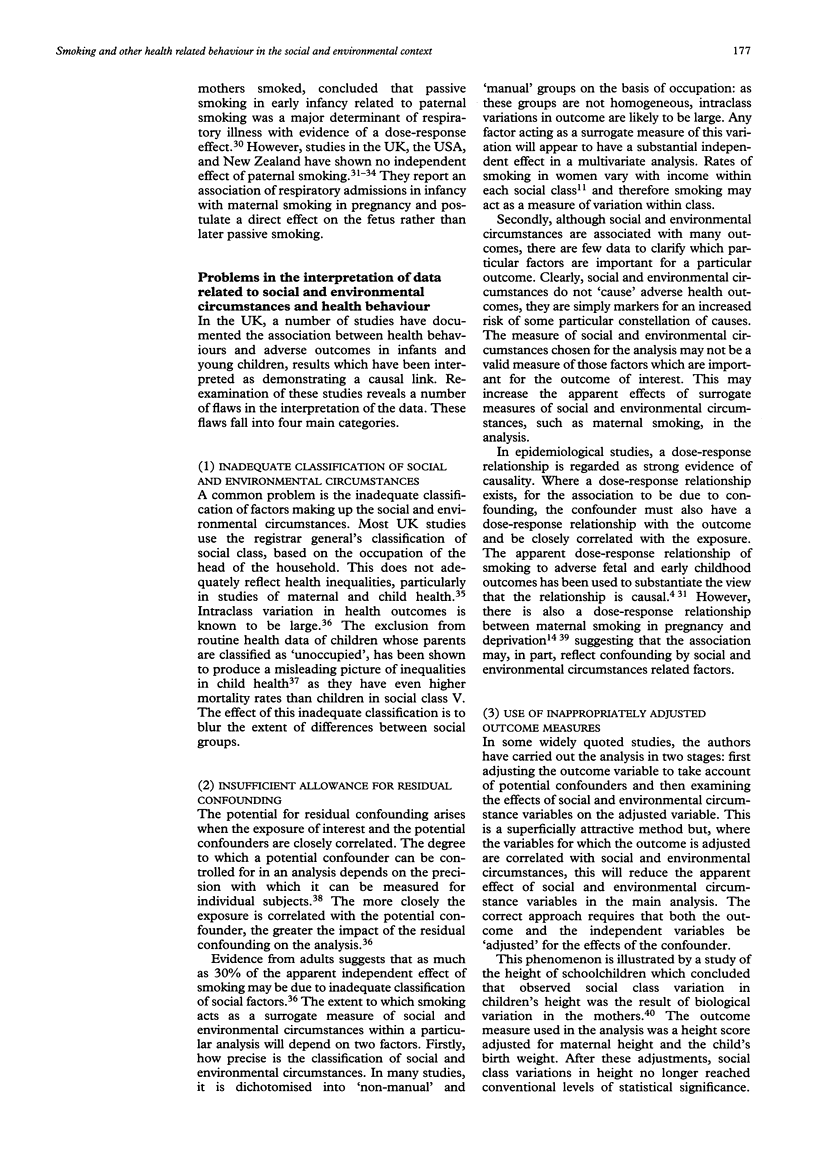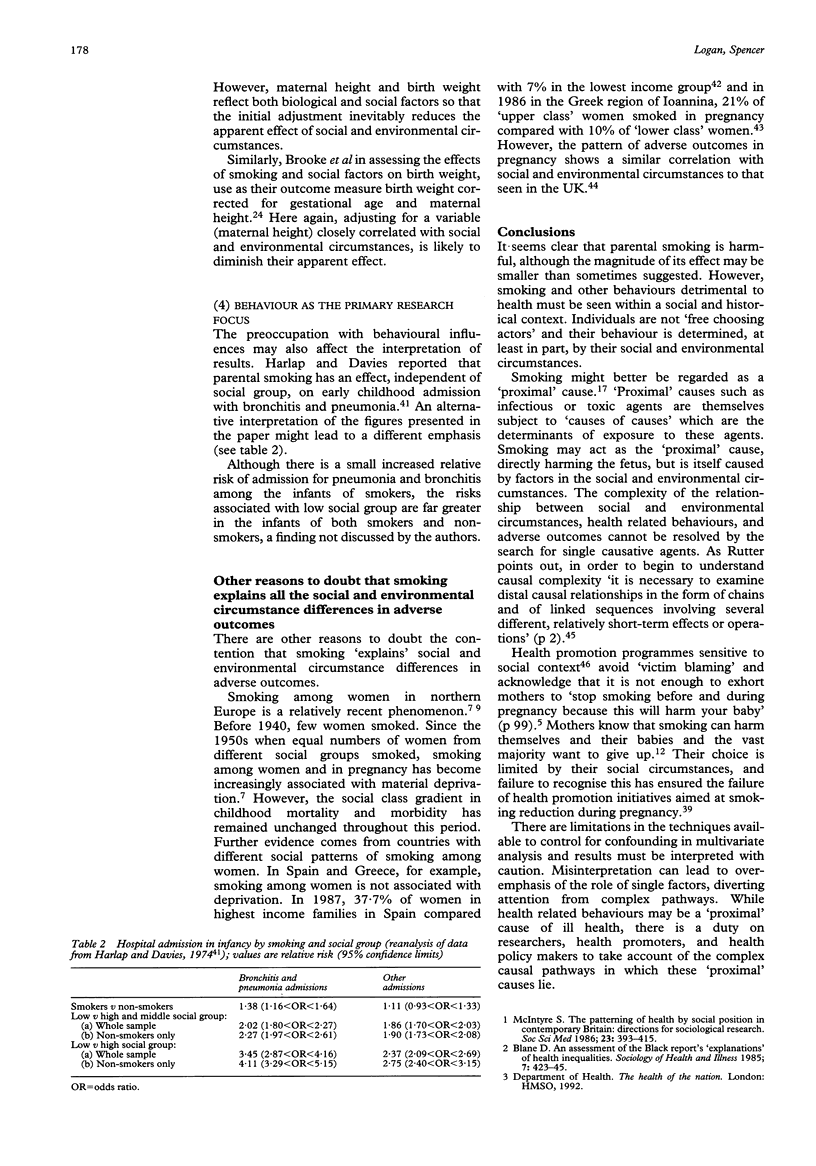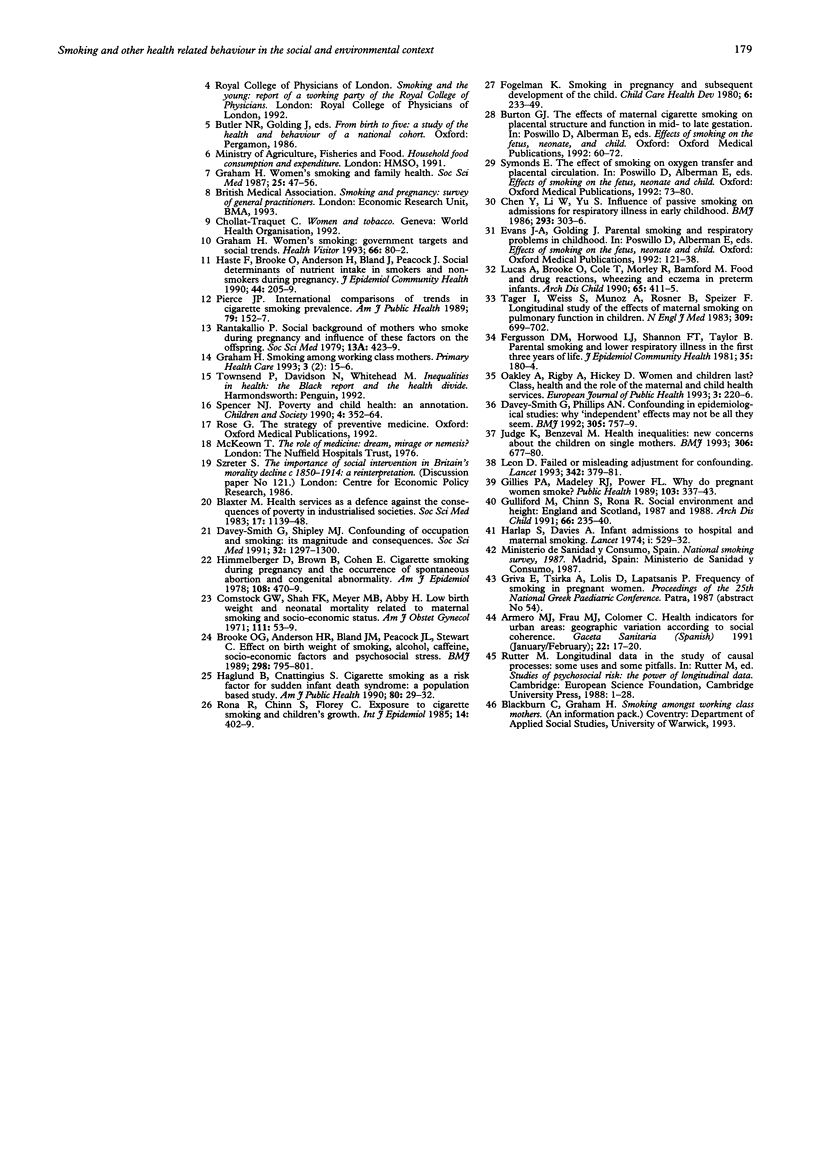Abstract
It seems clear that parental smoking is harmful, although the magnitude of its effect may be smaller than sometimes suggested. However, smoking and other behaviours detrimental to health must be seen within a social and historical context. Individuals are not 'free choosing actors' and their behaviour is determined, at least in part, by their social and environmental circumstances. Smoking might better be regarded as a 'proximal' cause. 'Proximal' causes such as infectious or toxic agents are themselves subject to 'causes of causes' which are the determinants of exposure to these agents. Smoking may act as the 'proximal' cause, directly harming the fetus, but is itself caused by factors in the social and environmental circumstances. The complexity of the relationship between social and environmental circumstances, health related behaviours, and adverse outcomes cannot be resolved by the search for single causative agents. As Rutter points out, in order to begin to understand causal complexity 'it is necessary to examine distal causal relationships in the form of chains and of linked sequences involving several different, relatively short-term effects or operations' (p 2). Health promotion programmes sensitive to social context avoid 'victim blaming' and acknowledge that it is not enough to exhort mothers to 'stop smoking before and during pregnancy because this will harm your baby' (p 99). Mothers know that smoking can harm themselves and their babies and the vast majority want to give up. Their choice is limited by their social circumstances, and failure to recognise this has ensured the failure of health promotion initiatives aimed at smoking reduction during pregnancy. There are limitations in the techniques available to control for confounding in multivariate analysis and results must be interpreted with caution. Misinterpretation can lead to overemphasis of the role of single factors, diverting attention from complex pathways. While health related behaviours may be a 'proximal' cause of ill health, there is a duty on researchers, health promoters, and health policy makers to take account of the complex causal pathways in which these 'proximal' causes lie.
Full text
PDF



Selected References
These references are in PubMed. This may not be the complete list of references from this article.
- Armero M. J., Frau M. J., Colomer C. Indicadores de salud en el medio urbano. Variaciones en función de la coherencia social de las áreas geográficas utilizadas. Gac Sanit. 1991 Jan-Feb;5(22):17–20. doi: 10.1016/s0213-9111(91)71044-3. [DOI] [PubMed] [Google Scholar]
- Blaxter M. Health services as a defence against the consequences of poverty in industrialised societies. Soc Sci Med. 1983;17(16):1139–1148. doi: 10.1016/0277-9536(83)90006-0. [DOI] [PubMed] [Google Scholar]
- Brooke O. G., Anderson H. R., Bland J. M., Peacock J. L., Stewart C. M. Effects on birth weight of smoking, alcohol, caffeine, socioeconomic factors, and psychosocial stress. BMJ. 1989 Mar 25;298(6676):795–801. doi: 10.1136/bmj.298.6676.795. [DOI] [PMC free article] [PubMed] [Google Scholar]
- Chen Y., Li W., Yu S. Influence of passive smoking on admissions for respiratory illness in early childhood. Br Med J (Clin Res Ed) 1986 Aug 2;293(6542):303–306. doi: 10.1136/bmj.293.6542.303. [DOI] [PMC free article] [PubMed] [Google Scholar]
- Comstock G. W., Shah F. K., Meyer M. B., Abbey H. Low birth weight and neonatal mortality rate related to maternal smoking and socioeconomic status. Am J Obstet Gynecol. 1971 Sep;111(1):53–59. doi: 10.1016/0002-9378(71)90926-4. [DOI] [PubMed] [Google Scholar]
- Fergusson D. M., Horwood L. J., Shannon F. T., Taylor B. Parental smoking and lower respiratory illness in the first three years of life. J Epidemiol Community Health. 1981 Sep;35(3):180–184. doi: 10.1136/jech.35.3.180. [DOI] [PMC free article] [PubMed] [Google Scholar]
- Fogelman K. Smoking in pregnancy and subsequent development of the child. Child Care Health Dev. 1980 Jul;6(4):233–249. doi: 10.1111/j.1365-2214.1980.tb00154.x. [DOI] [PubMed] [Google Scholar]
- Gillies P. A., Madeley R. J., Power F. L. Why do pregnant women smoke? Public Health. 1989 Sep;103(5):337–343. doi: 10.1016/s0033-3506(89)80003-4. [DOI] [PubMed] [Google Scholar]
- Graham H. Women's smoking and family health. Soc Sci Med. 1987;25(1):47–56. doi: 10.1016/0277-9536(87)90206-1. [DOI] [PubMed] [Google Scholar]
- Graham H. Women's smoking: government targets and social trends. Health Visit. 1993 Mar;66(3):80–82. [PubMed] [Google Scholar]
- Gulliford M. C., Chinn S., Rona R. J. Social environment and height: England and Scotland 1987 and 1988. Arch Dis Child. 1991 Feb;66(2):235–240. doi: 10.1136/adc.66.2.235. [DOI] [PMC free article] [PubMed] [Google Scholar]
- Haglund B., Cnattingius S. Cigarette smoking as a risk factor for sudden infant death syndrome: a population-based study. Am J Public Health. 1990 Jan;80(1):29–32. doi: 10.2105/ajph.80.1.29. [DOI] [PMC free article] [PubMed] [Google Scholar]
- Harlap S., Davies A. M. Infant admissions to hospital and maternal smoking. Lancet. 1974 Mar 30;1(7857):529–532. doi: 10.1016/s0140-6736(74)92714-7. [DOI] [PubMed] [Google Scholar]
- Haste F. M., Brooke O. G., Anderson H. R., Bland J. M., Peacock J. L. Social determinants of nutrient intake in smokers and non-smokers during pregnancy. J Epidemiol Community Health. 1990 Sep;44(3):205–209. doi: 10.1136/jech.44.3.205. [DOI] [PMC free article] [PubMed] [Google Scholar]
- Himmelberger D. U., Brown B. W., Jr, cohen E. N. Cigarette smoking during pregnancy and the occurrence of spontaneous abortion and congenital abnormality. Am J Epidemiol. 1978 Dec;108(6):470–479. doi: 10.1093/oxfordjournals.aje.a112645. [DOI] [PubMed] [Google Scholar]
- Judge K., Benzeval M. Health inequalities: new concerns about the children of single mothers. BMJ. 1993 Mar 13;306(6879):677–680. doi: 10.1136/bmj.306.6879.677. [DOI] [PMC free article] [PubMed] [Google Scholar]
- Lucas A., Brooke O. G., Cole T. J., Morley R., Bamford M. F. Food and drug reactions, wheezing, and eczema in preterm infants. Arch Dis Child. 1990 Apr;65(4):411–415. doi: 10.1136/adc.65.4.411. [DOI] [PMC free article] [PubMed] [Google Scholar]
- Macintyre S. The patterning of health by social position in contemporary Britain: directions for sociological research. Soc Sci Med. 1986;23(4):393–415. doi: 10.1016/0277-9536(86)90082-1. [DOI] [PubMed] [Google Scholar]
- Pierce J. P. International comparisons of trends in cigarette smoking prevalence. Am J Public Health. 1989 Feb;79(2):152–157. doi: 10.2105/ajph.79.2.152. [DOI] [PMC free article] [PubMed] [Google Scholar]
- Rantakallio P. Social background of mothers who smoke during pregnancy and influence of these factors on the offspring. Soc Sci Med. 1979 Jun;13A(4):423–429. [PubMed] [Google Scholar]
- Rona R. J., Chinn S., Florey C. D. Exposure to cigarette smoking and children's growth. Int J Epidemiol. 1985 Sep;14(3):402–409. doi: 10.1093/ije/14.3.402. [DOI] [PubMed] [Google Scholar]
- Smith G. D., Phillips A. N. Confounding in epidemiological studies: why "independent" effects may not be all they seem. BMJ. 1992 Sep 26;305(6856):757–759. doi: 10.1136/bmj.305.6856.757. [DOI] [PMC free article] [PubMed] [Google Scholar]
- Smith G. D., Shipley M. J. Confounding of occupation and smoking: its magnitude and consequences. Soc Sci Med. 1991;32(11):1297–1300. doi: 10.1016/0277-9536(91)90046-f. [DOI] [PubMed] [Google Scholar]
- Tager I. B., Weiss S. T., Muñoz A., Rosner B., Speizer F. E. Longitudinal study of the effects of maternal smoking on pulmonary function in children. N Engl J Med. 1983 Sep 22;309(12):699–703. doi: 10.1056/NEJM198309223091204. [DOI] [PubMed] [Google Scholar]


